Analysis of Nursing Code of Conduct and Annotated Bibliography Report
VerifiedAdded on 2023/06/07
|9
|1484
|405
Report
AI Summary
This report is divided into two main parts. Part A identifies key terms such as 'efficacy,' 'medication safety,' and 'quantitative,' along with additional terms like 'code of practice' and 'quality practice.' It also lists eight relevant journal articles published within the last five years, covering topics like nurses' ...

PART A & B
Paraphrase This Document
Need a fresh take? Get an instant paraphrase of this document with our AI Paraphraser
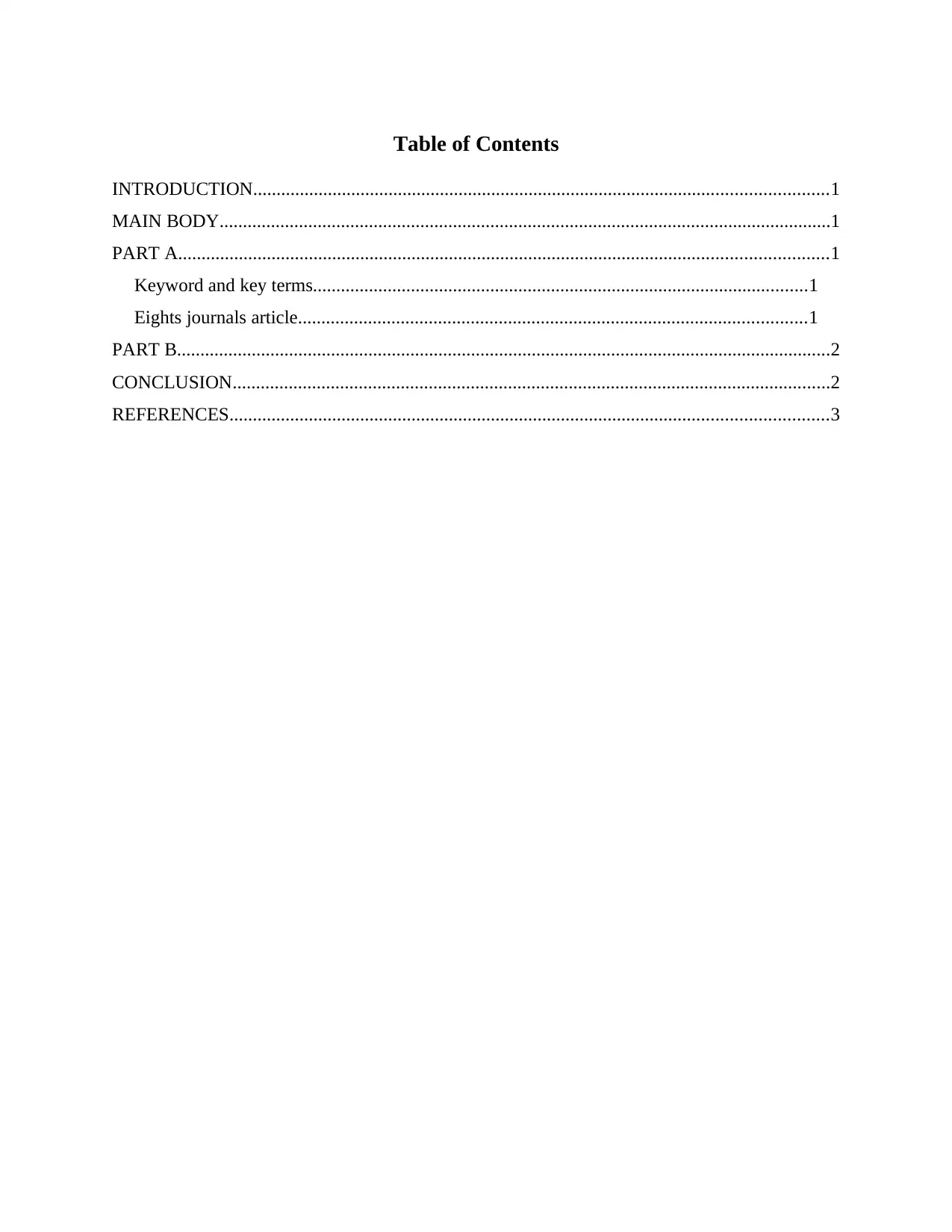
Table of Contents
INTRODUCTION...........................................................................................................................1
MAIN BODY...................................................................................................................................1
PART A...........................................................................................................................................1
Keyword and key terms..........................................................................................................1
Eights journals article.............................................................................................................1
PART B............................................................................................................................................2
CONCLUSION................................................................................................................................2
REFERENCES................................................................................................................................3
INTRODUCTION...........................................................................................................................1
MAIN BODY...................................................................................................................................1
PART A...........................................................................................................................................1
Keyword and key terms..........................................................................................................1
Eights journals article.............................................................................................................1
PART B............................................................................................................................................2
CONCLUSION................................................................................................................................2
REFERENCES................................................................................................................................3
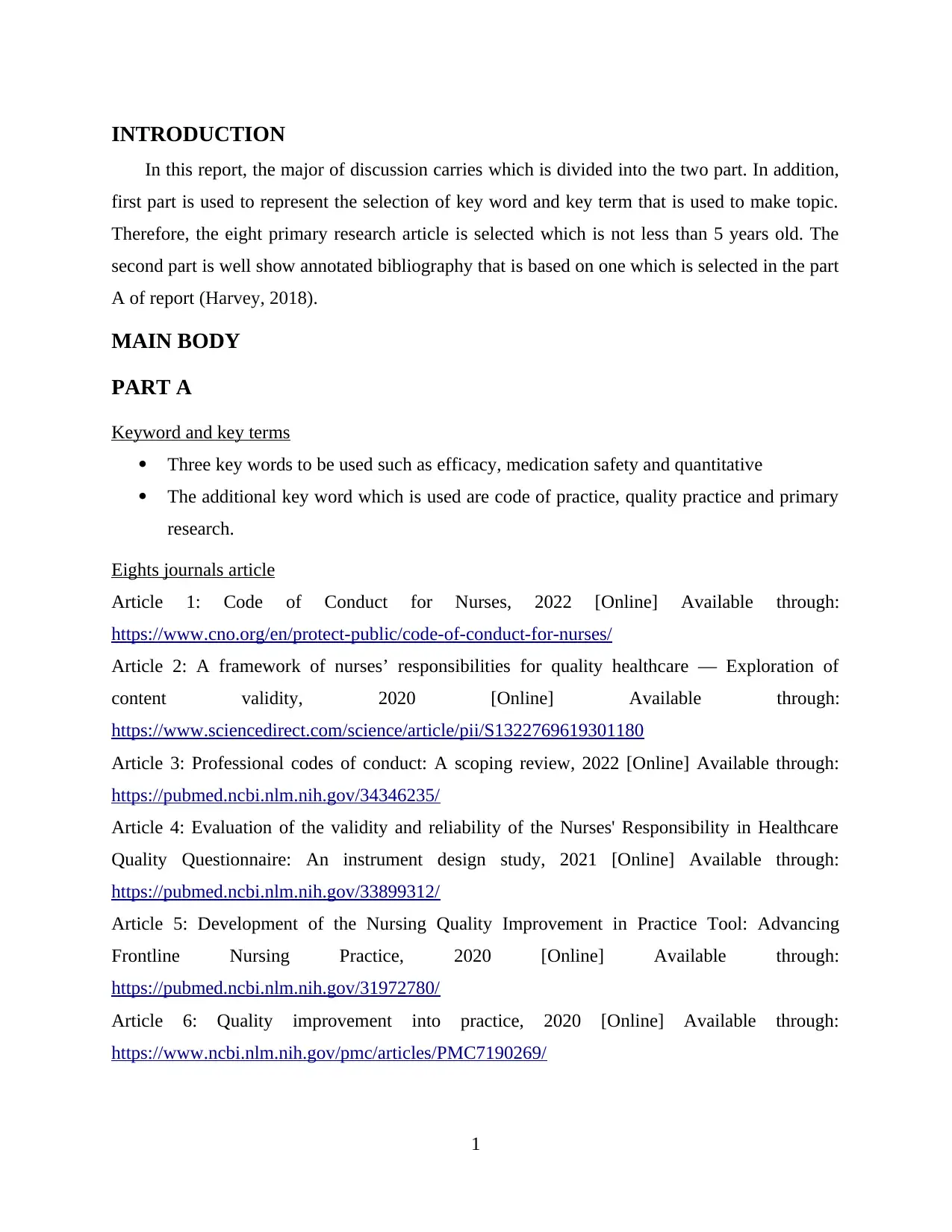
INTRODUCTION
In this report, the major of discussion carries which is divided into the two part. In addition,
first part is used to represent the selection of key word and key term that is used to make topic.
Therefore, the eight primary research article is selected which is not less than 5 years old. The
second part is well show annotated bibliography that is based on one which is selected in the part
A of report (Harvey, 2018).
MAIN BODY
PART A
Keyword and key terms
Three key words to be used such as efficacy, medication safety and quantitative
The additional key word which is used are code of practice, quality practice and primary
research.
Eights journals article
Article 1: Code of Conduct for Nurses, 2022 [Online] Available through:
https://www.cno.org/en/protect-public/code-of-conduct-for-nurses/
Article 2: A framework of nurses’ responsibilities for quality healthcare — Exploration of
content validity, 2020 [Online] Available through:
https://www.sciencedirect.com/science/article/pii/S1322769619301180
Article 3: Professional codes of conduct: A scoping review, 2022 [Online] Available through:
https://pubmed.ncbi.nlm.nih.gov/34346235/
Article 4: Evaluation of the validity and reliability of the Nurses' Responsibility in Healthcare
Quality Questionnaire: An instrument design study, 2021 [Online] Available through:
https://pubmed.ncbi.nlm.nih.gov/33899312/
Article 5: Development of the Nursing Quality Improvement in Practice Tool: Advancing
Frontline Nursing Practice, 2020 [Online] Available through:
https://pubmed.ncbi.nlm.nih.gov/31972780/
Article 6: Quality improvement into practice, 2020 [Online] Available through:
https://www.ncbi.nlm.nih.gov/pmc/articles/PMC7190269/
1
In this report, the major of discussion carries which is divided into the two part. In addition,
first part is used to represent the selection of key word and key term that is used to make topic.
Therefore, the eight primary research article is selected which is not less than 5 years old. The
second part is well show annotated bibliography that is based on one which is selected in the part
A of report (Harvey, 2018).
MAIN BODY
PART A
Keyword and key terms
Three key words to be used such as efficacy, medication safety and quantitative
The additional key word which is used are code of practice, quality practice and primary
research.
Eights journals article
Article 1: Code of Conduct for Nurses, 2022 [Online] Available through:
https://www.cno.org/en/protect-public/code-of-conduct-for-nurses/
Article 2: A framework of nurses’ responsibilities for quality healthcare — Exploration of
content validity, 2020 [Online] Available through:
https://www.sciencedirect.com/science/article/pii/S1322769619301180
Article 3: Professional codes of conduct: A scoping review, 2022 [Online] Available through:
https://pubmed.ncbi.nlm.nih.gov/34346235/
Article 4: Evaluation of the validity and reliability of the Nurses' Responsibility in Healthcare
Quality Questionnaire: An instrument design study, 2021 [Online] Available through:
https://pubmed.ncbi.nlm.nih.gov/33899312/
Article 5: Development of the Nursing Quality Improvement in Practice Tool: Advancing
Frontline Nursing Practice, 2020 [Online] Available through:
https://pubmed.ncbi.nlm.nih.gov/31972780/
Article 6: Quality improvement into practice, 2020 [Online] Available through:
https://www.ncbi.nlm.nih.gov/pmc/articles/PMC7190269/
1
⊘ This is a preview!⊘
Do you want full access?
Subscribe today to unlock all pages.

Trusted by 1+ million students worldwide
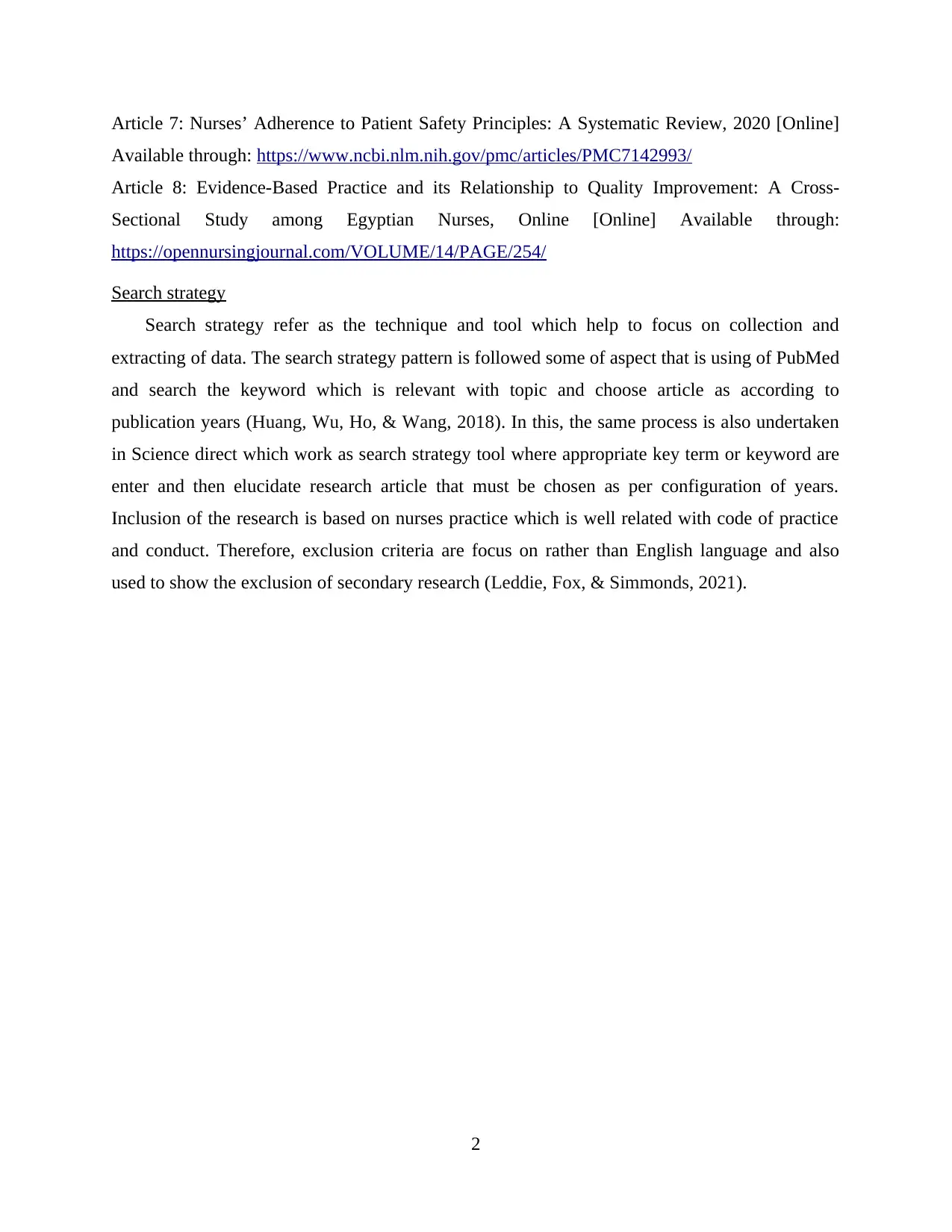
Article 7: Nurses’ Adherence to Patient Safety Principles: A Systematic Review, 2020 [Online]
Available through: https://www.ncbi.nlm.nih.gov/pmc/articles/PMC7142993/
Article 8: Evidence-Based Practice and its Relationship to Quality Improvement: A Cross-
Sectional Study among Egyptian Nurses, Online [Online] Available through:
https://opennursingjournal.com/VOLUME/14/PAGE/254/
Search strategy
Search strategy refer as the technique and tool which help to focus on collection and
extracting of data. The search strategy pattern is followed some of aspect that is using of PubMed
and search the keyword which is relevant with topic and choose article as according to
publication years (Huang, Wu, Ho, & Wang, 2018). In this, the same process is also undertaken
in Science direct which work as search strategy tool where appropriate key term or keyword are
enter and then elucidate research article that must be chosen as per configuration of years.
Inclusion of the research is based on nurses practice which is well related with code of practice
and conduct. Therefore, exclusion criteria are focus on rather than English language and also
used to show the exclusion of secondary research (Leddie, Fox, & Simmonds, 2021).
2
Available through: https://www.ncbi.nlm.nih.gov/pmc/articles/PMC7142993/
Article 8: Evidence-Based Practice and its Relationship to Quality Improvement: A Cross-
Sectional Study among Egyptian Nurses, Online [Online] Available through:
https://opennursingjournal.com/VOLUME/14/PAGE/254/
Search strategy
Search strategy refer as the technique and tool which help to focus on collection and
extracting of data. The search strategy pattern is followed some of aspect that is using of PubMed
and search the keyword which is relevant with topic and choose article as according to
publication years (Huang, Wu, Ho, & Wang, 2018). In this, the same process is also undertaken
in Science direct which work as search strategy tool where appropriate key term or keyword are
enter and then elucidate research article that must be chosen as per configuration of years.
Inclusion of the research is based on nurses practice which is well related with code of practice
and conduct. Therefore, exclusion criteria are focus on rather than English language and also
used to show the exclusion of secondary research (Leddie, Fox, & Simmonds, 2021).
2
Paraphrase This Document
Need a fresh take? Get an instant paraphrase of this document with our AI Paraphraser
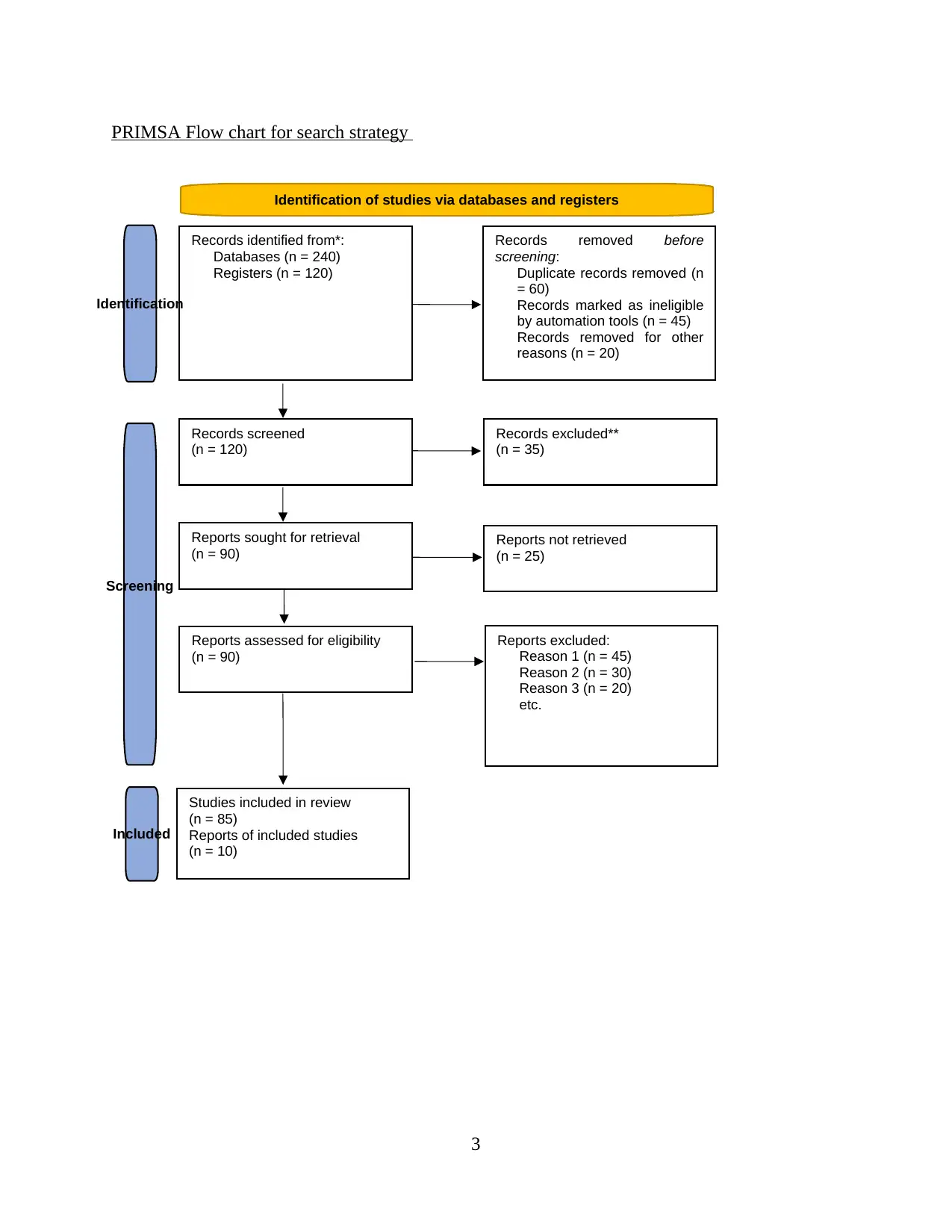
PRIMSA Flow chart for search strategy
3
Records identified from*:
Databases (n = 240)
Registers (n = 120)
Records removed before
screening:
Duplicate records removed (n
= 60)
Records marked as ineligible
by automation tools (n = 45)
Records removed for other
reasons (n = 20)
Records screened
(n = 120)
Records excluded**
(n = 35)
Reports sought for retrieval
(n = 90) Reports not retrieved
(n = 25)
Reports assessed for eligibility
(n = 90)
Reports excluded:
Reason 1 (n = 45)
Reason 2 (n = 30)
Reason 3 (n = 20)
etc.
Studies included in review
(n = 85)
Reports of included studies
(n = 10)
Identification of studies via databases and registers
Identification
Screening
Included
3
Records identified from*:
Databases (n = 240)
Registers (n = 120)
Records removed before
screening:
Duplicate records removed (n
= 60)
Records marked as ineligible
by automation tools (n = 45)
Records removed for other
reasons (n = 20)
Records screened
(n = 120)
Records excluded**
(n = 35)
Reports sought for retrieval
(n = 90) Reports not retrieved
(n = 25)
Reports assessed for eligibility
(n = 90)
Reports excluded:
Reason 1 (n = 45)
Reason 2 (n = 30)
Reason 3 (n = 20)
etc.
Studies included in review
(n = 85)
Reports of included studies
(n = 10)
Identification of studies via databases and registers
Identification
Screening
Included
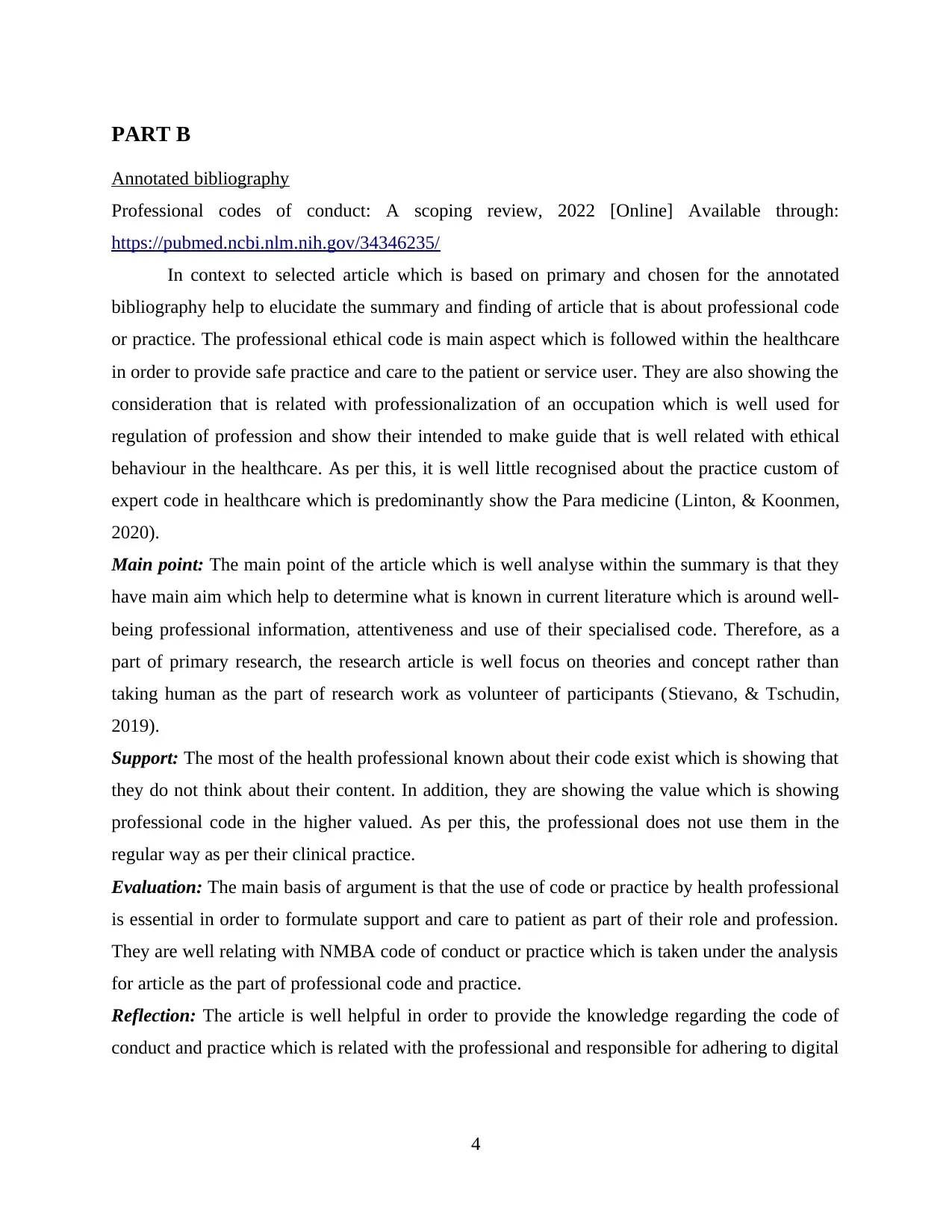
PART B
Annotated bibliography
Professional codes of conduct: A scoping review, 2022 [Online] Available through:
https://pubmed.ncbi.nlm.nih.gov/34346235/
In context to selected article which is based on primary and chosen for the annotated
bibliography help to elucidate the summary and finding of article that is about professional code
or practice. The professional ethical code is main aspect which is followed within the healthcare
in order to provide safe practice and care to the patient or service user. They are also showing the
consideration that is related with professionalization of an occupation which is well used for
regulation of profession and show their intended to make guide that is well related with ethical
behaviour in the healthcare. As per this, it is well little recognised about the practice custom of
expert code in healthcare which is predominantly show the Para medicine (Linton, & Koonmen,
2020).
Main point: The main point of the article which is well analyse within the summary is that they
have main aim which help to determine what is known in current literature which is around well-
being professional information, attentiveness and use of their specialised code. Therefore, as a
part of primary research, the research article is well focus on theories and concept rather than
taking human as the part of research work as volunteer of participants (Stievano, & Tschudin,
2019).
Support: The most of the health professional known about their code exist which is showing that
they do not think about their content. In addition, they are showing the value which is showing
professional code in the higher valued. As per this, the professional does not use them in the
regular way as per their clinical practice.
Evaluation: The main basis of argument is that the use of code or practice by health professional
is essential in order to formulate support and care to patient as part of their role and profession.
They are well relating with NMBA code of conduct or practice which is taken under the analysis
for article as the part of professional code and practice.
Reflection: The article is well helpful in order to provide the knowledge regarding the code of
conduct and practice which is related with the professional and responsible for adhering to digital
4
Annotated bibliography
Professional codes of conduct: A scoping review, 2022 [Online] Available through:
https://pubmed.ncbi.nlm.nih.gov/34346235/
In context to selected article which is based on primary and chosen for the annotated
bibliography help to elucidate the summary and finding of article that is about professional code
or practice. The professional ethical code is main aspect which is followed within the healthcare
in order to provide safe practice and care to the patient or service user. They are also showing the
consideration that is related with professionalization of an occupation which is well used for
regulation of profession and show their intended to make guide that is well related with ethical
behaviour in the healthcare. As per this, it is well little recognised about the practice custom of
expert code in healthcare which is predominantly show the Para medicine (Linton, & Koonmen,
2020).
Main point: The main point of the article which is well analyse within the summary is that they
have main aim which help to determine what is known in current literature which is around well-
being professional information, attentiveness and use of their specialised code. Therefore, as a
part of primary research, the research article is well focus on theories and concept rather than
taking human as the part of research work as volunteer of participants (Stievano, & Tschudin,
2019).
Support: The most of the health professional known about their code exist which is showing that
they do not think about their content. In addition, they are showing the value which is showing
professional code in the higher valued. As per this, the professional does not use them in the
regular way as per their clinical practice.
Evaluation: The main basis of argument is that the use of code or practice by health professional
is essential in order to formulate support and care to patient as part of their role and profession.
They are well relating with NMBA code of conduct or practice which is taken under the analysis
for article as the part of professional code and practice.
Reflection: The article is well helpful in order to provide the knowledge regarding the code of
conduct and practice which is related with the professional and responsible for adhering to digital
4
⊘ This is a preview!⊘
Do you want full access?
Subscribe today to unlock all pages.

Trusted by 1+ million students worldwide
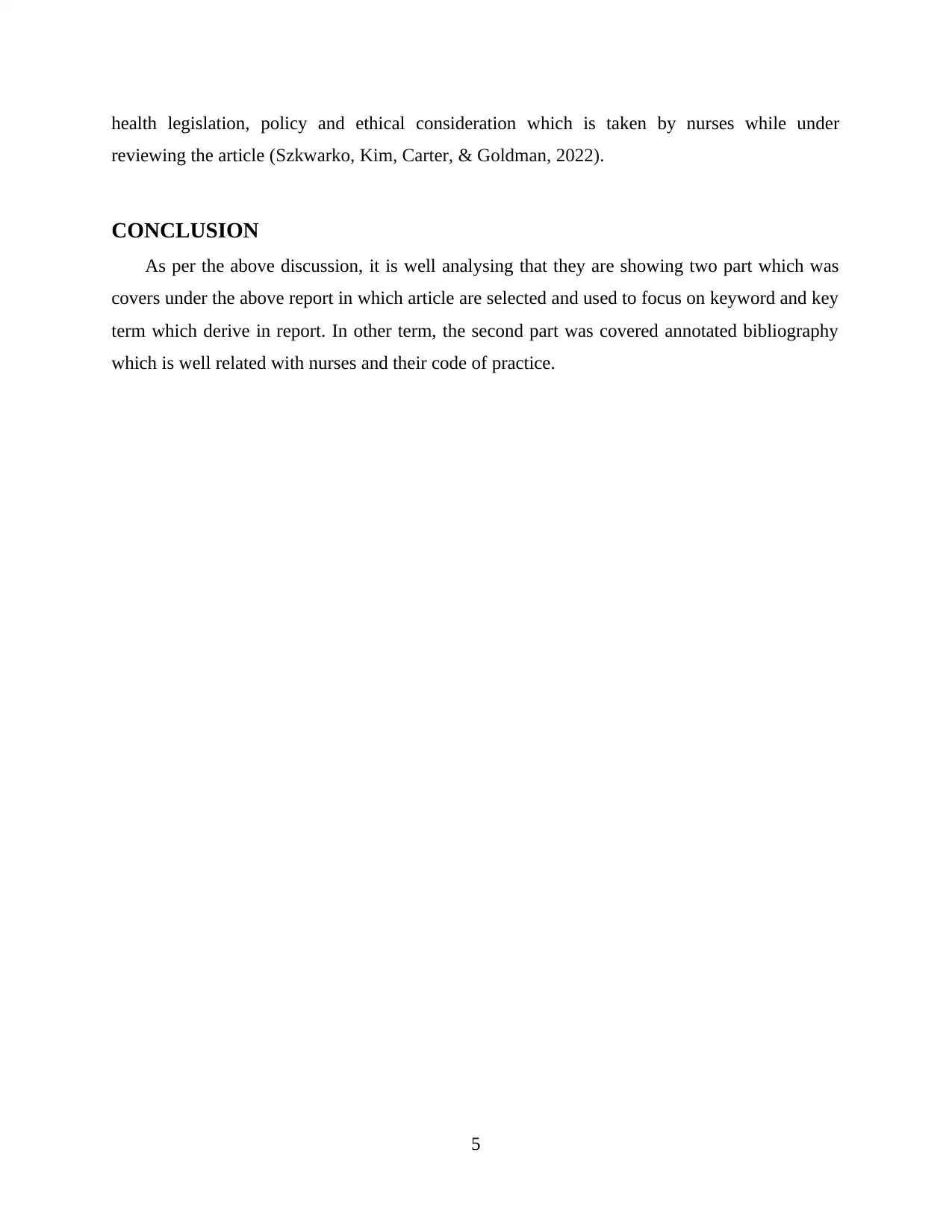
health legislation, policy and ethical consideration which is taken by nurses while under
reviewing the article (Szkwarko, Kim, Carter, & Goldman, 2022).
CONCLUSION
As per the above discussion, it is well analysing that they are showing two part which was
covers under the above report in which article are selected and used to focus on keyword and key
term which derive in report. In other term, the second part was covered annotated bibliography
which is well related with nurses and their code of practice.
5
reviewing the article (Szkwarko, Kim, Carter, & Goldman, 2022).
CONCLUSION
As per the above discussion, it is well analysing that they are showing two part which was
covers under the above report in which article are selected and used to focus on keyword and key
term which derive in report. In other term, the second part was covered annotated bibliography
which is well related with nurses and their code of practice.
5
Paraphrase This Document
Need a fresh take? Get an instant paraphrase of this document with our AI Paraphraser
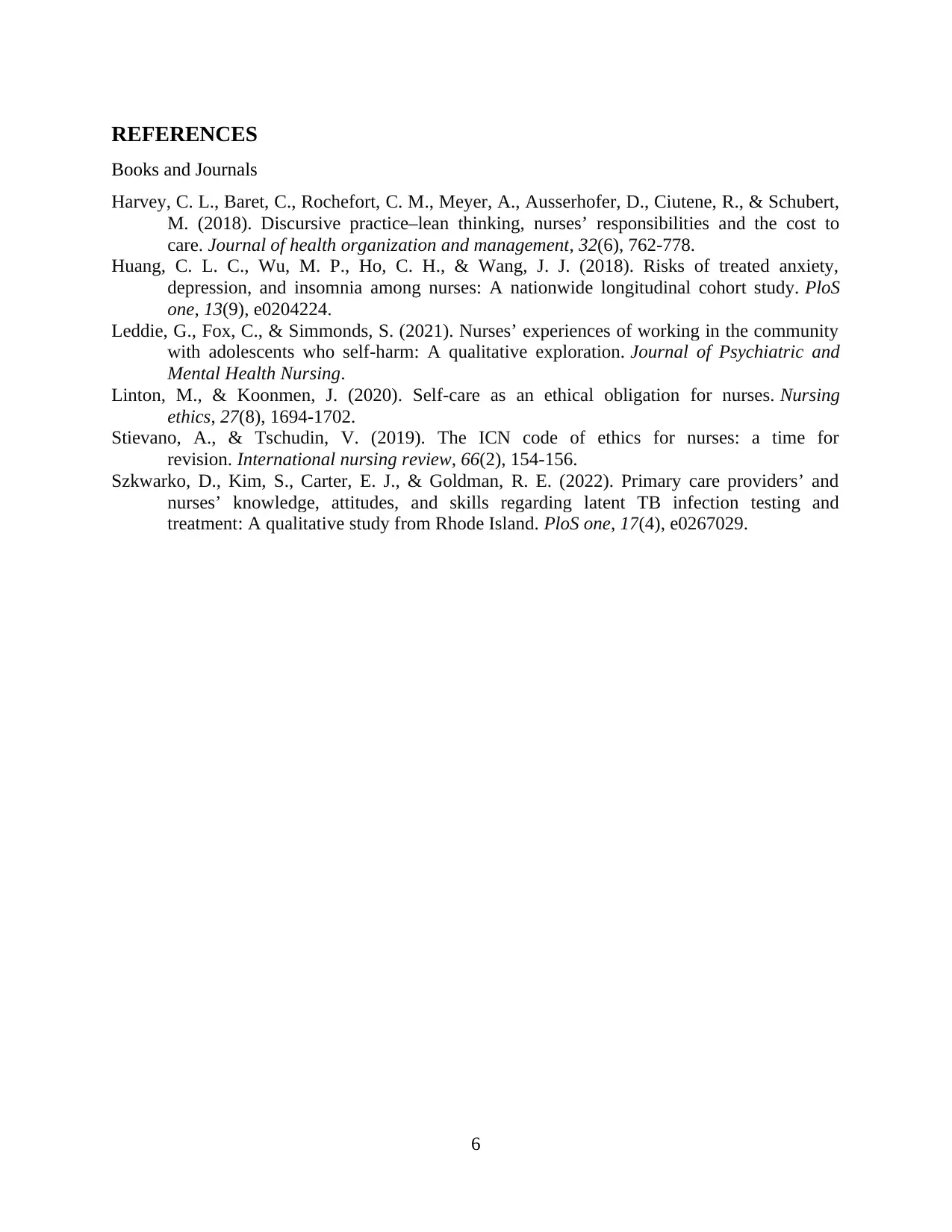
REFERENCES
Books and Journals
Harvey, C. L., Baret, C., Rochefort, C. M., Meyer, A., Ausserhofer, D., Ciutene, R., & Schubert,
M. (2018). Discursive practice–lean thinking, nurses’ responsibilities and the cost to
care. Journal of health organization and management, 32(6), 762-778.
Huang, C. L. C., Wu, M. P., Ho, C. H., & Wang, J. J. (2018). Risks of treated anxiety,
depression, and insomnia among nurses: A nationwide longitudinal cohort study. PloS
one, 13(9), e0204224.
Leddie, G., Fox, C., & Simmonds, S. (2021). Nurses’ experiences of working in the community
with adolescents who self‐harm: A qualitative exploration. Journal of Psychiatric and
Mental Health Nursing.
Linton, M., & Koonmen, J. (2020). Self-care as an ethical obligation for nurses. Nursing
ethics, 27(8), 1694-1702.
Stievano, A., & Tschudin, V. (2019). The ICN code of ethics for nurses: a time for
revision. International nursing review, 66(2), 154-156.
Szkwarko, D., Kim, S., Carter, E. J., & Goldman, R. E. (2022). Primary care providers’ and
nurses’ knowledge, attitudes, and skills regarding latent TB infection testing and
treatment: A qualitative study from Rhode Island. PloS one, 17(4), e0267029.
6
Books and Journals
Harvey, C. L., Baret, C., Rochefort, C. M., Meyer, A., Ausserhofer, D., Ciutene, R., & Schubert,
M. (2018). Discursive practice–lean thinking, nurses’ responsibilities and the cost to
care. Journal of health organization and management, 32(6), 762-778.
Huang, C. L. C., Wu, M. P., Ho, C. H., & Wang, J. J. (2018). Risks of treated anxiety,
depression, and insomnia among nurses: A nationwide longitudinal cohort study. PloS
one, 13(9), e0204224.
Leddie, G., Fox, C., & Simmonds, S. (2021). Nurses’ experiences of working in the community
with adolescents who self‐harm: A qualitative exploration. Journal of Psychiatric and
Mental Health Nursing.
Linton, M., & Koonmen, J. (2020). Self-care as an ethical obligation for nurses. Nursing
ethics, 27(8), 1694-1702.
Stievano, A., & Tschudin, V. (2019). The ICN code of ethics for nurses: a time for
revision. International nursing review, 66(2), 154-156.
Szkwarko, D., Kim, S., Carter, E. J., & Goldman, R. E. (2022). Primary care providers’ and
nurses’ knowledge, attitudes, and skills regarding latent TB infection testing and
treatment: A qualitative study from Rhode Island. PloS one, 17(4), e0267029.
6

7
⊘ This is a preview!⊘
Do you want full access?
Subscribe today to unlock all pages.

Trusted by 1+ million students worldwide
1 out of 9
Related Documents
Your All-in-One AI-Powered Toolkit for Academic Success.
+13062052269
info@desklib.com
Available 24*7 on WhatsApp / Email
![[object Object]](/_next/static/media/star-bottom.7253800d.svg)
Unlock your academic potential
© 2024 | Zucol Services PVT LTD | All rights reserved.





